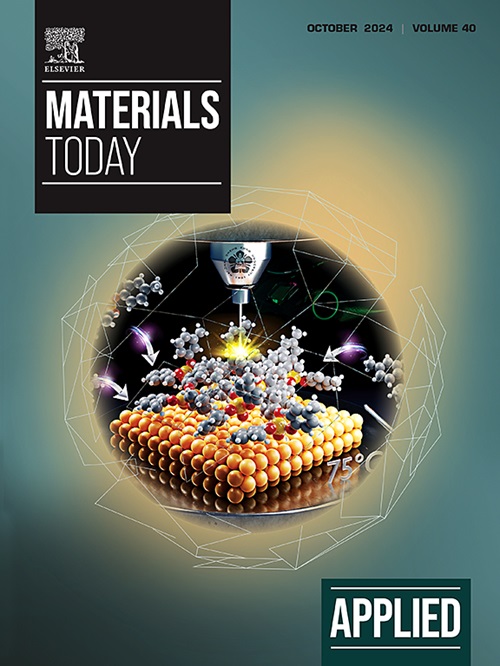Oxidative stress-responsive hydrogen sulfide-releasing composite hydrogel for refractory diabetic wounds repair
IF 6.9
2区 材料科学
Q1 MATERIALS SCIENCE, MULTIDISCIPLINARY
引用次数: 0
Abstract
While revascularization is acknowledged as a critical process in wound healing, the scenario becomes more complex when considering diabetic wounds. In such cases, oxidative stress introduces two primary challenges that impede the healing process: ensuring the directional movement of functional cells to the wound site and combating the heightened risk of infection. These challenges underscore the need for innovative therapeutic strategies that can effectively address these restrictions in the context of diabetic wound healing. Hydrogen sulfide (HS) acts as a signaling gas and shows significant therapeutic potential in biomedical research. In this study, we encapsulate Allicin, a natural HS donor, in selenium micelles that specifically respond to oxidative stress. To create the GMA (Allicin@Micelle-GelMA) Composite hydrogel system, we utilize Methacrylic anhydride gelatin (GelMA) hydrogel as a matrix and form it through in-situ light curing. This composite system effectively addresses the problem of healing deep, narrow, and lengthy wounds that pose a challenge, as well as preventing nonspecific sudden release of HS. Additionally, the composite hydrogel system promotes angiogenesis, anti-inflammatory, antibacterial, and antioxidant properties. It also facilitates the directional movement of stem cells and macrophages, as demonstrated through the chicken embryo chorioallantoic membrane vascular test and the establishment of a diabetes wound model that is difficult to heal. Consequently, we conclude that the GMA composite hydrogel has the potential to serve as a versatile skin wound dressing that can effectively respond to oxidative stress.用于难治性糖尿病伤口修复的氧化应激响应型硫化氢释放复合水凝胶
虽然血管再通被认为是伤口愈合的关键过程,但如果考虑到糖尿病伤口,情况就会变得更加复杂。在这种情况下,氧化应激带来了两个阻碍伤口愈合的主要挑战:确保功能细胞定向移动到伤口部位,以及应对增加的感染风险。这些挑战突出表明,在糖尿病伤口愈合的背景下,需要能有效解决这些限制的创新治疗策略。硫化氢(HS)是一种信号气体,在生物医学研究中显示出巨大的治疗潜力。在这项研究中,我们将天然硫化氢供体大蒜素封装在硒胶束中,这种胶束能专门应对氧化应激。为了创建 GMA(大蒜素@胶束-GelMA)复合水凝胶系统,我们使用甲基丙烯酸酐明胶(GelMA)水凝胶作为基质,并通过原位光固化形成。这种复合系统能有效解决深、窄、长伤口的愈合难题,并能防止 HS 的非特异性突然释放。此外,复合水凝胶系统还能促进血管生成、抗炎、抗菌和抗氧化。它还有利于干细胞和巨噬细胞的定向移动,这一点已通过鸡胚绒毛膜血管试验和建立难以愈合的糖尿病伤口模型得到证实。因此,我们得出结论:GMA 复合水凝胶有望成为一种多功能皮肤伤口敷料,能有效应对氧化应激。
本文章由计算机程序翻译,如有差异,请以英文原文为准。
求助全文
约1分钟内获得全文
求助全文
来源期刊

Applied Materials Today
Materials Science-General Materials Science
CiteScore
14.90
自引率
3.60%
发文量
393
审稿时长
26 days
期刊介绍:
Journal Name: Applied Materials Today
Focus:
Multi-disciplinary, rapid-publication journal
Focused on cutting-edge applications of novel materials
Overview:
New materials discoveries have led to exciting fundamental breakthroughs.
Materials research is now moving towards the translation of these scientific properties and principles.
文献相关原料
公司名称
产品信息
阿拉丁
polyethylene glycol monomethyl ether
阿拉丁
tetrahydrofuran
阿拉丁
methylene chloride
阿拉丁
ethyl acetate
阿拉丁
anhydrous sodium sulfate
阿拉丁
toluene diisocyanate
阿拉丁
selenium powder
阿拉丁
sodium borohydride
阿拉丁
Phosphate buffer
阿拉丁
N,N-dimethylformamide
 求助内容:
求助内容: 应助结果提醒方式:
应助结果提醒方式:


